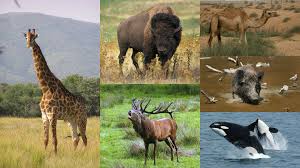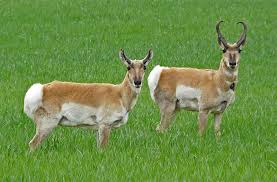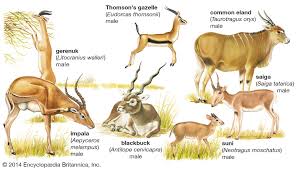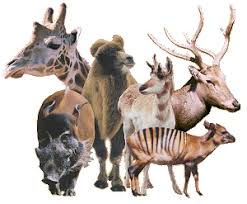The Artiodactyla are known as ‘even-toed’ ungulates due to the body weight resting on two digits (the third and fourth) or on all four digits (the second to fifth) of each foot. These species are herbivores, feeding on grasses and herbs (grazers) or shrubs and trees (browsers).
They are found throughout the country, showcasing great diversity in size and structure. Of the three sub-orders under this order, two are represented in Nigeria:
i. Suiformes, which includes pigs (family Suidae) and hippopotamuses (family Hippopotamidae), and
ii. Ruminantia, which includes the giraffe (family Giraffidae), water chevrotain (family Tragulidae), and African buffalo and antelopes (family Bovidae).
Read Also: Challenges and Potential of Snail Farming
Diversity and Distribution of Artiodactyla in Nigeria

Members of this order are widespread throughout the country, demonstrating considerable variation in size and form. These species are primarily herbivores and form a significant biomass, feeding on grasses or shrubs and trees.
Given their generally large size and abundance, they can significantly influence local vegetation. Unfortunately, due to overhunting, poaching, and habitat destruction, their numbers have declined.
The order is divided into three sub-orders, but only Suiformes and Ruminantia are present in Nigeria.
Suiformes are non-ruminants with simple stomachs, while Ruminantia are ruminants with complex digestive systems. The stomach may have three chambers (Tragulidae) or four chambers (Happold, 1987).
Key to the Families of Artiodactyla in Nigeria (Happold, 1987)

- Upper incisors present, horns absent, non-ruminant go to 2
- Upper incisors absent, horns present (except in Tragulidae and females of some Bovidae), ruminants go to 3
- Muzzle broad, body hairless, thickset limbs, with two central and two lateral digits supporting body weight, aquatic or semi-aquatic Hippopotamidae
- Muzzle elongated, ending in a flat disc around the nostrils, body with few or many bristles, often with a mane on the dorsal surface, two central digits on each foot supporting body weight, two lateral digits do not support weight, terrestrial Suidae
- Horns absent in both sexes, upper canine teeth elongated into small tusks, three-chambered stomach, small size (WT not more than 16kg), Tragulidae
- Horns present (except in some females — see Table 1), upper canines absent, four-chambered stomach, size varies from small to very large — go to 7
- Very large (WT up to 1180kg), neck and legs extremely elongated, horns very short and covered with skin and hair, two digits only on each foot, pelage with a pattern of large dark blotches Giraffidae.
- Small to large, neck and legs not particularly elongated, horns (if present) not covered with skin and hair, two central digits supporting body weight, two lateral digits do not touch the ground, pelage without a pattern of large dark blotches Bovidae
Table 1: Suborders and Families of Artiodactyla in Nigeria
| Suborder | Family (Common name) | No. of digits on foot | No. of stomach chambers | Upper canines | Horns | Teeth characteristics | Species in Nigeria |
|---|---|---|---|---|---|---|---|
| Suiformes | Suidae (pigs) | 2+2 | 2 | Yes | No | Upper and lower canines form tusks | 3 |
| Suiformes | Hippopotamidae (hippopotamuses) | 4 | 3 | Yes | No | Lower canines form tusks | 2 |
| Ruminantia | Tragulidae (water chevrotain) | 2+2 | 3 | Yes | No | Upper canines form tusks | 1 |
| Ruminantia | Giraffidae (giraffe) | 2 | 4 | No | Yes (covered by hair) | No upper incisors, no tusks | 1 |
| Ruminantia | Bovidae (buffalo, antelopes) | 2+2 | 4 | No | Yes, but absent in some females | No upper incisors, no tusks | 25 |
| 2+2 = two digits touch the ground; two digits higher up on the back of the foot do not touch the ground. Source: Happold, 1973 |
Read Also: The Complete Guide to Snail Farming Technique
Common Artiodactyl Species in Nigeria

The following are the characteristic features of some common Artiodactyla species in Nigeria.
1. Warthog (Phacochoerus aethiopicus): The warthog is a large pig with an enormous head and well-developed tusks. Males are larger and heavier than females. Skin is grey, with sparse bristles, and more elongated bristles on the dorsal surface of the neck and shoulders. Warthogs are found in savannah habitats, preferring flood plains and areas near water. They live in small family groups and are strictly diurnal.
2. Hippopotamus (Hippopotamus amphibius): The hippopotamus is a large semi-aquatic mammal, known for its barrel-shaped body and short legs. Their skin is brownish-grey and hairless except for the muzzle and inner ears. Hippopotamuses live in schools of 2-13 individuals in Nigeria and feed exclusively on land at night.
3. Giraffe (Giraffa camelopardalis): The giraffe is the tallest land mammal, with long necks and legs. They are characterized by unique chestnut-brown patches on their beige or sandy body. Giraffes live in small herds, typically fewer than 10 individuals.
4. African Buffalo (Syncerus caffer)
African buffalo are large, barrel-shaped herbivores with thickset legs. Both sexes have large horns, and they live in herds that change frequently in size and composition.
5. Bushbuck (Tragelaphus scriptus)
This medium-sized antelope is known for its bold white stripes and spots on its reddish-brown body. Bushbuck live alone or in pairs and are known to hide their young after birth.
6. Giant Eland (Taurotragus derbianus)
The giant eland is a heavily-built antelope with long spiral horns and rufous pelage. They are nocturnal and live in herds of 3-20 individuals.
7. Maxwell’s Duiker (Cephalophus maxwelli)
This small, lightly-built duiker has slate-grey to grey-brown pelage and small pointed horns. They are nocturnal and live singly or in pairs.
9. Kob (Kobus kob)
The kob is a medium-sized antelope with golden-brown pelage and long S-shaped horns in males. Kobs are grazers and live in herds of varying sizes.
10. Roan Antelope (Hippotragus equinus)
The roan antelope is one of the largest antelope species in the Nigerian savannah. It has beige to dark tan pelage, with black or dark faces and long scimitar-shaped horns.
This article discussed the Artiodactyla order, commonly referred to as even-toed ungulates. These herbivores feed on grasses and herbs or shrubs and trees. Two sub-orders, Suiformes and Ruminantia, are present in Nigeria. The article also explored the key to identifying the different families of Artiodactyla, as well as their features and common species found in the country.
Do you have any questions, suggestions, or contributions? If so, please feel free to use the comment box below to share your thoughts. We also encourage you to kindly share this information with others who might benefit from it. Since we can’t reach everyone at once, we truly appreciate your help in spreading the word. Thank you so much for your support and for sharing!
Read Also: What You Need To Know About Fitness Centers

